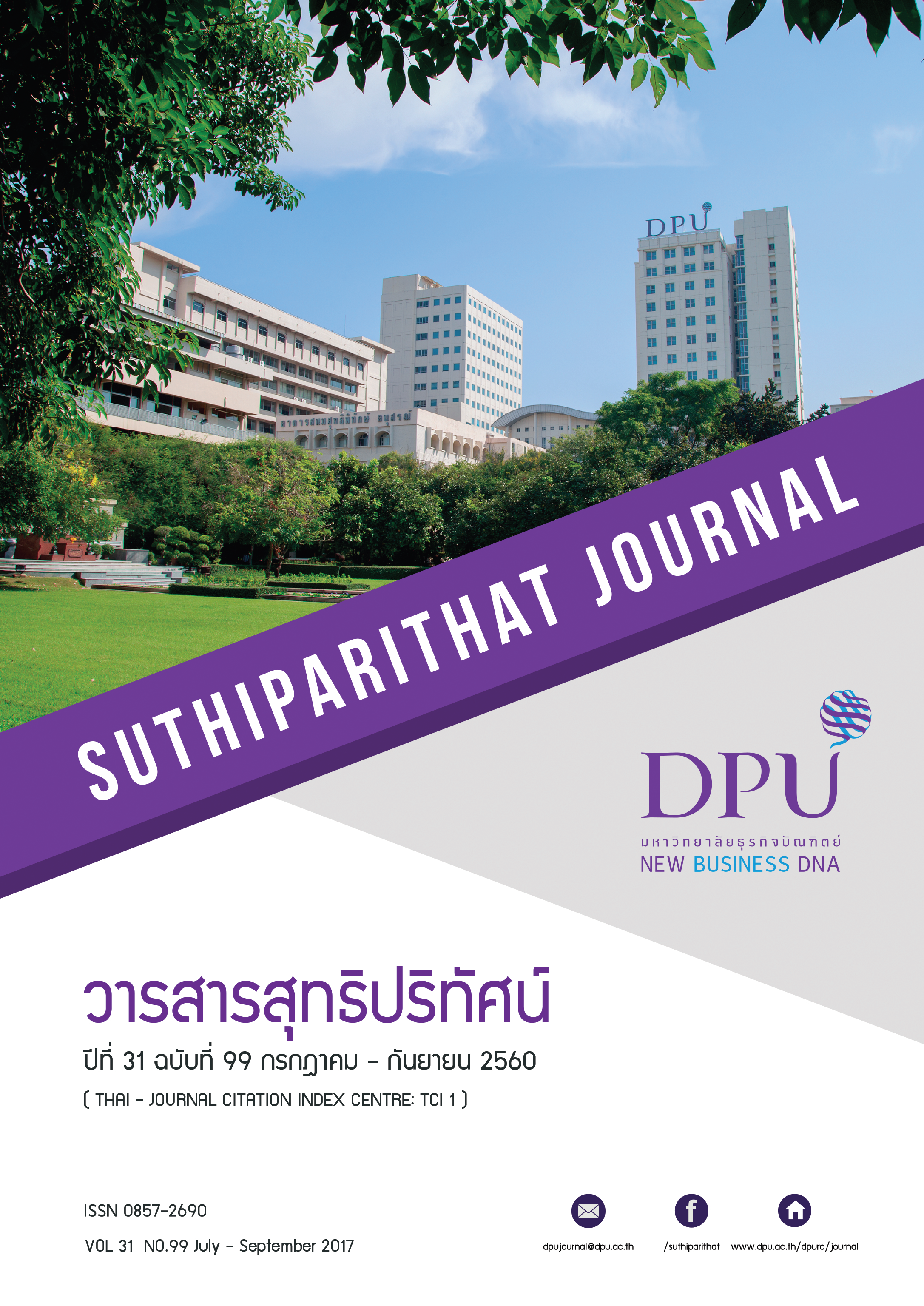ปัจจัยที่ส่งผลต่อความสำเร็จของสโมสรฟุตบอลในการแข่งขันฟุตบอลไทยลีก
คำสำคัญ:
การสนับสนุนตราสินค้า, ความเป็นนานาชาติ, ความสำเร็จของสโมสร, การแข่งขันฟุตบอลไทยลีกบทคัดย่อ
การวิจัยเรื่องนี้มีวัตถุประสงค์เพื่อศึกษาปัจจัยที่ส่งผลต่อความสำเร็จของสโมสรฟุตบอล ในการแข่งขันฟุตบอลไทย โดยเก็บข้อมูลจากผู้ชมฟุตบอลที่ถือตั๋วปีของ 5 สโมสรที่มีจำนวนผู้ชมสูงสุด ในฤดูกาลแข่งขันปี พ.ศ. 2559 จำนวน 457 คน ใช้ค่าทางสถิติวิเคราะห์ข้อมูลโดยใช้สถิติเชิงพรรณาและ ทดสอบสมมติฐานโดยใช้สถิติการวิเคราะห์องค์ประกอบเชิงยืนยัน (Confirmatory Factor Analysis) และการวิเคราะห์สมการโครงสร้าง (Structural Equation Modeling)
ผลการวิจัยพบว่าตัวอย่างส่วนใหญ่เป็นเพศชาย อยู่ในช่วงอายุ 26-32 ปี มีการศึกษาในระดับ ปริญญาตรี ประกอบอาชีพธุรกิจส่วนตัว/อาชีพอิสระ และมีรายได้ประมาณ 20,001 – 25,000 บาทต่อเดือน ปัจจัยด้านการสนับสนุนตราสินค้าที่ได้รับคะแนนความคิดเห็นสูงสุดคือ คิดว่าสโมสรที่ใช้ชื่อจังหวัดเป็นชื่อทีมจะสร้างความภูมิใจให้ประชาชนของจังหวัดนั้นๆ (ตราสินค้าเดี่ยว) และปัจจัยด้านความเป็นนานาชาติ ที่ได้รับคะแนนความคิดเห็นสูงสุด คือ คิดว่าการมีผู้เล่นชาวต่างชาติในสโมสรจะช่วยดึงดูดให้มีผู้ชมมาเป็น สมาชิกของทีมได้
ผลการทดสอบสมมติฐานพบว่า การสนับสนุนตราสินค้า (Brand Endorsement) และความเป็นนานาชาติ (Internationalization) ของสโมสรมีอิทธิพลเชิงบวกต่อความสำเร็จของสโมสรในการแข่งขัน ฟุตบอลไทยลีกอย่างมีนัยสำคัญที่ระดับ 0.05
เอกสารอ้างอิง
กอบกาญจน์ พุทธาศรี, วรางคณา อดิศรประเสริฐ, และศุภิญญา ญาณสมบูรณ์. (2554). ปัจจัยที่มีอิทธิพลต่อความรักและความภักดีต่อสโมสรฟุตบอลไทยพรีเมียร์ลีก. วารสารมหาวิทยาลัยราชภัฏมหาสารคาม ปีที่ 1 ฉบับที่ 6 หน้า 160.
บริษัทไทยแลนด์พรีเมียร์ลีก จำกัด. (2559). รายงานประจำปีบริษัทไทยแลนด์พรีเมียร์ลีกจำกัด. สืบค้น 10 มกราคม 2560, จาก www.tpldb.com/ข้อมูล/เพิ่มเติม/บริษัท-ไทยพรีเมียร์ลีก-จำกัด
Ascari, G. and Gagnepain, P. (2006). Spanish football. Journal of Sport Economics, 7(1), 76-89.
Balmer, J. M. T. (2001). The three virtues and seven deadly sins of corporate brand management. Journal of General Management, 27(1), 1-17.
Baroncelli, A. and Lago, U. (2004). “Il settore del calcio”, in Baroncelli, A., Lago, U. and Szymanski, S. (Eds), Il business del calcio. Successi sportivi e rovesci finanziari, Egea editore, Milano.
Bergami M. and Bagozzi R. P. (2000). Self-categorization, affective commitment and group self-esteem as distinct aspects of social identity in the organization. Journal of Social Phychology, 33(4), 555-557.
Bodet, G. (2008).Customer satisfaction and loyalty in service: two concepts, four constructs, several Relationships. Journal of Retailing and Consumer Services, 15(3), 156-162.
Bodet, G. and Chanavat, N. (2010). Building global football brand equity: Lessons from the Chinese market. Asia Pacific Journal of Marketing and Logistics, 22(1), 55-66.
Cochran, W. G. (1977). Sampling Techniques. 3d ed. New York : John Wiley and Sons Inc.
Dobson, S. and Goddard, J. (2011). The Economics of Football, 2nd ed., Cambridge University Press, Cambridge.
Davcik, N. S., Vinhas da S., R., and Hair, J.F.(2015). Towards a unified theory of brand equity : conceptualizations, taxonomy and avenues for future research. The Journal of Product and Brand Management, 24(1), 3-17.
Falkheimer J. (2007). Events framed by the mass media: media coverage and effects of America’s Cup preregatta in Sweden. Journal of event management, 11(1), 81-88.
Kotler, P., Amstrong, G., Saunders, J. and Wong, V. (1999). Principles of Marketing, Prentice Hall Europe, London.
Kern, A. Schwarzmann, M.and Wiedenegger, A. (2012). Measuring the efficiency of English Premier League football: A two-stage data envelopment analysis approach. Sport, Business and Management: An International Journal, 2(3), 177-195.
Madichie N. (2009). Management implications of foreign players in the English Premiership League football. Management Decision, 47(1), 24-50.
Mason, D. (1999). What is the sports product and who buys it? The marketing of professional sports leagues, European Journal of Marketing, 33(3), 402-19.
Molnar, G. and Maguire, J. (2008). Hungarian footballers on the move: Issues of and observations on the first migratory phase, Sport in Society, 11(1), 74-89.
Motion, J., Leitch, S.and Brodie, R. J. (2003). Equity in corporate co-branding: The case of adidas and the All Biacks. European Journal of Marketing, 37(7), 1080-1094.
Olson, E. M., Duray, R., Cooper, C. and Olson, K. M. (2016). Strategy, structure, and culture within the English Premier League: an examination of large clubs.Sport, Business and Management: An International Journal, 6(1), 55-75.
Vigneron, F. and Johnson, L. W. (2004). Measuring perceptions of brand luxury. The Journal of Brand Management. 11(6), 484-506.
ดาวน์โหลด
เผยแพร่แล้ว
รูปแบบการอ้างอิง
ฉบับ
ประเภทบทความ
สัญญาอนุญาต
เนื้อหาและข้อมูลในบทความที่ลงตีพิมพ์ในวารสารสุทธิปริทัศน์ ถือเป็นข้อคิดเห็นและความรับผิดชอบของผู้เขียนบทความโดยตรงซึ่งกองบรรณาธิการวารสาร ไม่จำเป็นต้องเห็นด้วย หรือร่วมรับผิดชอบใด ๆ
บทความ ข้อมูล เนื้อหา รูปภาพ ฯลฯ ที่ได้รับการตีพิมพ์ในวารสารสุทธิปริทัศน์ ถือเป็นลิขสิทธิ์ของวารสารสุทธิปริทัศน์หากบุคคลหรือหน่วยงานใดต้องการนำทั้งหมดหรือส่วนหนึ่งส่วนใดไปเผยแพร่ต่อหรือเพื่อกระทำการใด ๆ จะต้องได้รับอนุญาตเป็นลายลักษณ์อักษรจากวารสารสุทธิปริทัศน์ก่อนเท่านั้น







